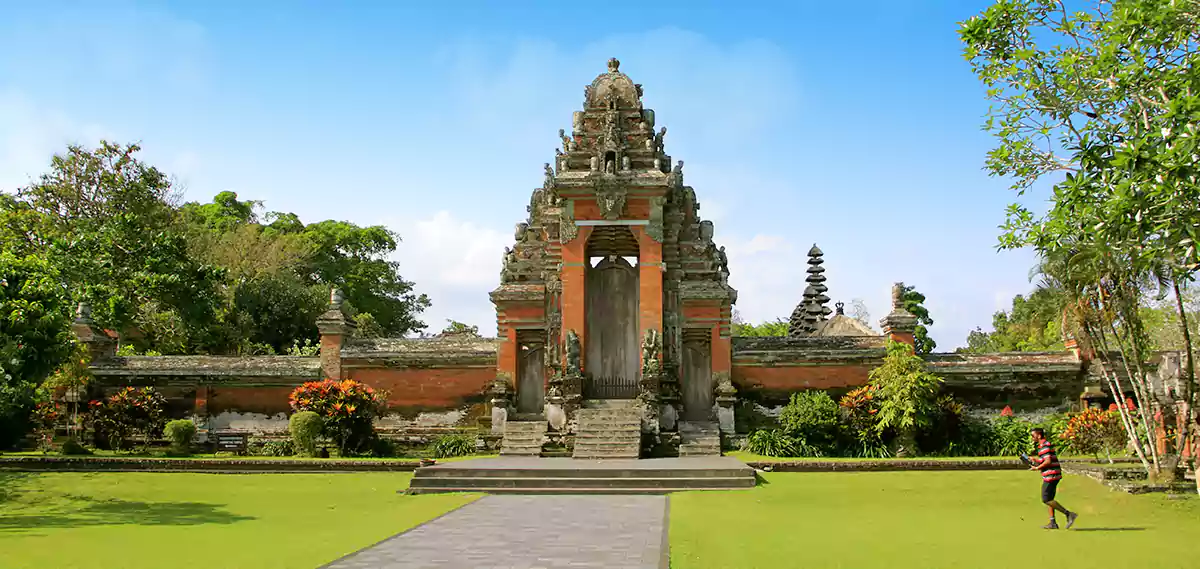Taman Ayun Temple, also known as Mengwi Royal Temple, is a Hindu temple in Mengwi, a village in Bali, Indonesia. The temple is about 18 kilometers northwest of the popular tourist destination of Denpasar, the capital city of Bali.
Taman Ayun Temple is a significant cultural and historical landmark in Bali. The Mengwi Kingdom built it in the 17th century, during a time when it was one of the dominant kingdoms in Bali. The temple served as the royal family temple of the Mengwi Kingdom. And also, people renowned it for its exquisite architecture and serene surroundings.
“Taman Ayun” translates to “Beautiful Garden” in Indonesian, perfectly describing the temple’s setting. A wide moat surrounds the complex, and lush gardens and manicured lawns create a peaceful atmosphere. The temple has multi-tiered meru (pagoda) towers and intricately carved stone gates and walls.

History of Taman Ayun Temple
According to the Lontar Chronicle of Mengwi, people formerly called the temple Taman Ahyun Temple when it underwent purification in 1634 AD. Now, people know it as Taman Ayun Temple. Ahyun came from the root word “Hyun,” which means desire, so Ahyun implies desire. The Mengwi Kingdom established Taman Ayun Temple in a garden (a pond with a beautiful flower garden) that fulfilled wishes. Ahyun’s words turned into Ayun’s words.
The history of this temple is present in the Lontar (a manuscript of palm leaves) of Dwijendra Tattwa. It describes that Danghyang Nirartha, during his travels in Bali. Once he did yoga in an area near a spring with blooming flower trees surrounding it. At that time, people have named the place Taman Sari or Taman Wulakan Temple. While they have called the surrounding area ‘Mangapuri.’ People has believe that the word ‘Mangapuri’ changed to ‘Mangui’ and is now famous as ‘Mengwi.’ ‘Manga’ or ‘Mango’ likely comes from the word ‘Mangu,’ which means ‘contemplation’ or ‘meditation.’ Based on this, Mangupuri means ‘a good place to practice yoga samadhi.
The Historical Background of the Temple
We can know the historical background of Taman Ayun Temple based on archaeological data. The local people found the date at the temple, especially in the Lontar Chronicle of Mengwi.
- Archaeological data. On the left front entrance of the door leading to the first courtyard (jaba side) of Taman Ayun temple. Two buildings are called “Batu Aya” and “Bedugul Krama Carik.” Also, there are relics from the megalithic tradition in stone petals called “menhirs,” arranged higher and higher. It was tapering to form a pyramidal terrace. People have used the location of Taman Ayun Temple as a site for ritual activities related to ‘fertility’ ceremonies in agriculture since the development of the megalithic tradition around 500 BC, as evidenced by these remains.
- Data in the Chronicle of Mengwi. It is said that I, Gusti Agung Putu, pioneered his power. It starts with the gift of a piece of forest land and the chosen people of 200 people from a chief of the Marga village area, namely I Gusti Bebalang. Forest land was encroached on. And I, Gusti Agung Putu, built a palace named “Puri Bala Ayu.” Now it becomes “Belayu.”

Function of Taman Ayun Temple
We can identify the function of the Taman Ayun Temple based on the contents of the Mengwi chronicle. Also, building structures and their respective roles, especially those in the third area (the main temple area).
Worship of Gods. Worshipers at Taman Ayun Temple honor the main deity, Istadewata, as a manifestation of Lord Vishnu. The locals believe that God Visnu resides at the top of Mount Mangu. People also call the Mengwi Chronicle ‘Hyanging Parwata Gunung Mangu’ or Bhatara Hyang Danawa. Meanwhile, in the Usana Balinese manuscript, one of the deities, Catur Lokapala, kept Bali stable, especially the Mengwi kingdom in its time. As a medium of worship, there is “Meru Pucak Pangelengan,” a temple building with nine layers on the east row. And also, to the left of Meru, there are 11 intersections with Bhatara Gunung Agung.
In the temple building row located in the north, a Prasada is approximately 4 meters high. People refer to it as the ‘Temple of Gading Cili,’ a place of the ‘Goddess of Gading Cili.’ It seems that ‘Goddess of Gading Cili’ is another name for ‘Goddess of Chile’ or Dewi Sri or Dewi Laksmi, the sacred wife of Lord Vishnu.
People see Dewi Sri as the ruler of agriculture, especially as the ‘Goddess of Rice’ or ‘Dewi Nini.’ Meanwhile, they see Goddess Lakshmi as the Goddess of the Earth (Bhudewi), the ruler of soil fertility and agricultural crops. Lord Vishnu and his divine Goddess Sri-Laksmi are the “Istadewata” of Taman Ayun Temple in their capacity or status as a legacy from the “Temple of the Kingdom of Mengwi.”
Places to Visit in Bali
Taman Ayun Temple is a famous tourist destination in Bali. The temple is open to visitors, and tourists can explore its beautiful grounds and admire the traditional Balinese architecture. The serene surroundings make Taman Ayun Temple a popular tourist attraction and a great place to learn about Bali’s rich cultural heritage.
The best time to visit Taman Ayun Temple in Bali, Indonesia, is during the dry season, typically from April to September. During this time, you can expect lower chances of rainfall and generally pleasant weather, making it more comfortable to explore the temple and its surroundings.
We recommend visiting in the morning or late afternoon to avoid the peak heat of the day. The temple opens at 9:00 AM, so arriving early allows you to explore the complex when it’s less crowded, providing a more peaceful and immersive experience. Additionally, the lighting during these times can be particularly beautiful, enhancing the overall atmosphere of the temple.



